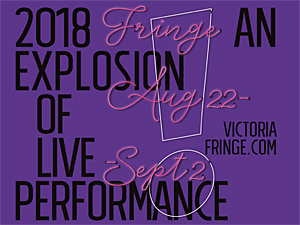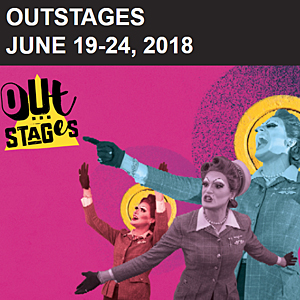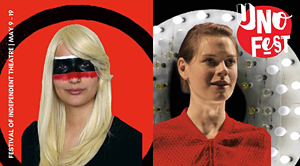This article was originally written for the online Charlebois Post in April 2013. Since this publication ceased operations in January 2015, I asked for permission to re-publish it here.
Promotions 101 for Fringe Artists
In an ever-evolving media landscape, the prospect of promoting a show on the Fringe circuit, whether in a single city, or across the country, may seem daunting. It needn’t be.
From my perspective, as theatre-goer, active arts blogger, and community public relations volunteer, there are a number of simple steps that Fringe artists can take to broaden their reach and attract a larger audience and fan base.
 Wall of flyers at the Ottawa Fringe Festival (from the CAFF website)
Wall of flyers at the Ottawa Fringe Festival (from the CAFF website)
Take charge and control what you can control
A website is essential. It can focus on the artist, the company, or the show, and be hosted on sites like WordPress.com, Blogger, Tumblr, Wix, Weebly, or self-hosted using WordPress.org or another CMS (content management system).
Purchase your own domain name (CanadianFringeArtist.com and not CanadianFringeArtist.wordpress.com).
On the website list a brief biography, production history, upcoming shows, and contact information. Include links to social media outposts like Twitter, Facebook, Tumblr, YouTube, and Google +.
Have a contact form and ensure that when people send a message, they receive one in return – for example: “Thank you for contacting me. I return messages within x days (hours)”.Link the contact form to an email in order to receive alerts when people are trying to reach you.
When using photos on your site remember to credit the photographer and link to their website.
Include a “subscribe using email” form. Any new posts will be pushed to subscribers so they don’t miss current information. Later, if you have the time to develop an email marketing campaign, you will have a start on your data base.
Ensure that all reviews are replicated on the site, preferably in text and not in individual pdf (an Adobe format) documents. Get permission from sources first. Do not simply link to the articles as many print media sources are retiring pages quickly. When quoting from a blog or website, include a link back as a courtesy.
Consider a “media” tab that includes your media release and press ready (high resolution) photos. Keep the media release to one page – have quotes from you, and quotes about you. Don’t forget to position the media release with your unique characteristics – why should someone be writing about you? Answer all the five “w” questions – who, what, where, when and why.
Build a fan base and tribe
After a website, think about social media profiles. Many artists use Facebook, Twitter, YouTube, or Tumblr; they can be invaluable for connecting not only with existing friends and fans, but for building an advance base in cities you will be visiting. Twitter in particular, due to its open structure and search capabilities, gives you the option to connect with people all over the country and create advance buzz for your show.
No matter where you decide to establish a social media presence, be there on a regular basis (or find someone to help you) – dedicate time daily to responding to people and be generous in sharing information from other artists too.
Other great examples of tribe building are crowd-sourced fundraising campaigns like IndieGoGo. When people donate they continue to receive messages about the progress of your efforts. For example, last summer (2012), I Will Not Hatch, based in Toronto, raised over $8000 to take their cast of 10 to the Edmonton Fringe.
The advantage to crowd-sourced fundraising over local efforts targeted to family and friends lies in not only the reach (potentially the world) but in the enduring nature of the site for online searches.
If your Fringe show is of interest to a particular demographic (knitters, Francophones, book lovers, people originally from Newfoundland) do some advance research and connect with clubs and associations in the cities you will be visiting. They may be willing to include information about your show in their tweets, newsletter, mail-out or Facebook page.
Don’t forget online calendars
As the size of print publications has decreased, online calendars have gained definite importance. Most newspapers and magazines have the option to submit an event online; many entertainment websites do as well. In Victoria alone there are close to 30 possible sites that span the range from Used Victoria and Craig’s List to Tourism Victoria and HarbourLiving. An added bonus is the additional social media posting done from the sites – a double or triple whammy of information.
Create a template post and find a volunteer to help you with this task as it can be tedious. Track the information and results using a spread sheet.
Connect with people who write about the Fringe
Follow the guidelines from each individual city regarding the approach to take with traditional media. You will receive this information in your Fringe Artist kit.
Find bloggers, vloggers and websites that are Fringe-friendly and develop a relationship with them. At the very least they may be willing to share your social media updates with their friends and followers, and ideally they will write or film a short piece about you too.
Don’t ignore standard Fringe promotional techniques
Flyering works! Get out there and work the lines – connect with people and don’t stop. You can be polite and relentless at the same time. If you need inspiration, just look to Fringe veteran Jem Rolls’ example.
Prepare an absolutely fantastic piece for Preview Night – practice until it is note perfect. Make no mistake, there are people judging you by your preview.
If you decide to offer free shows to volunteers, post them early in your run. Volunteers love to spread the word.
Team Up
The Fringe circuit can be a lonely place. Teaming up with other artists helps to create synergy. You can flyer together, promote shows in shout-outs at the end of your show – get creative with the possibilities.
And finally
Have fun on the Fringe. Let me know if you’re coming to Victoria this summer or next, and remember – you don’t have to do it all. It’s better to start in small manageable steps and build to a level that is comfortable for you than undertake a complicated public relations strategy that you cannot maintain.





Speak Your Mind